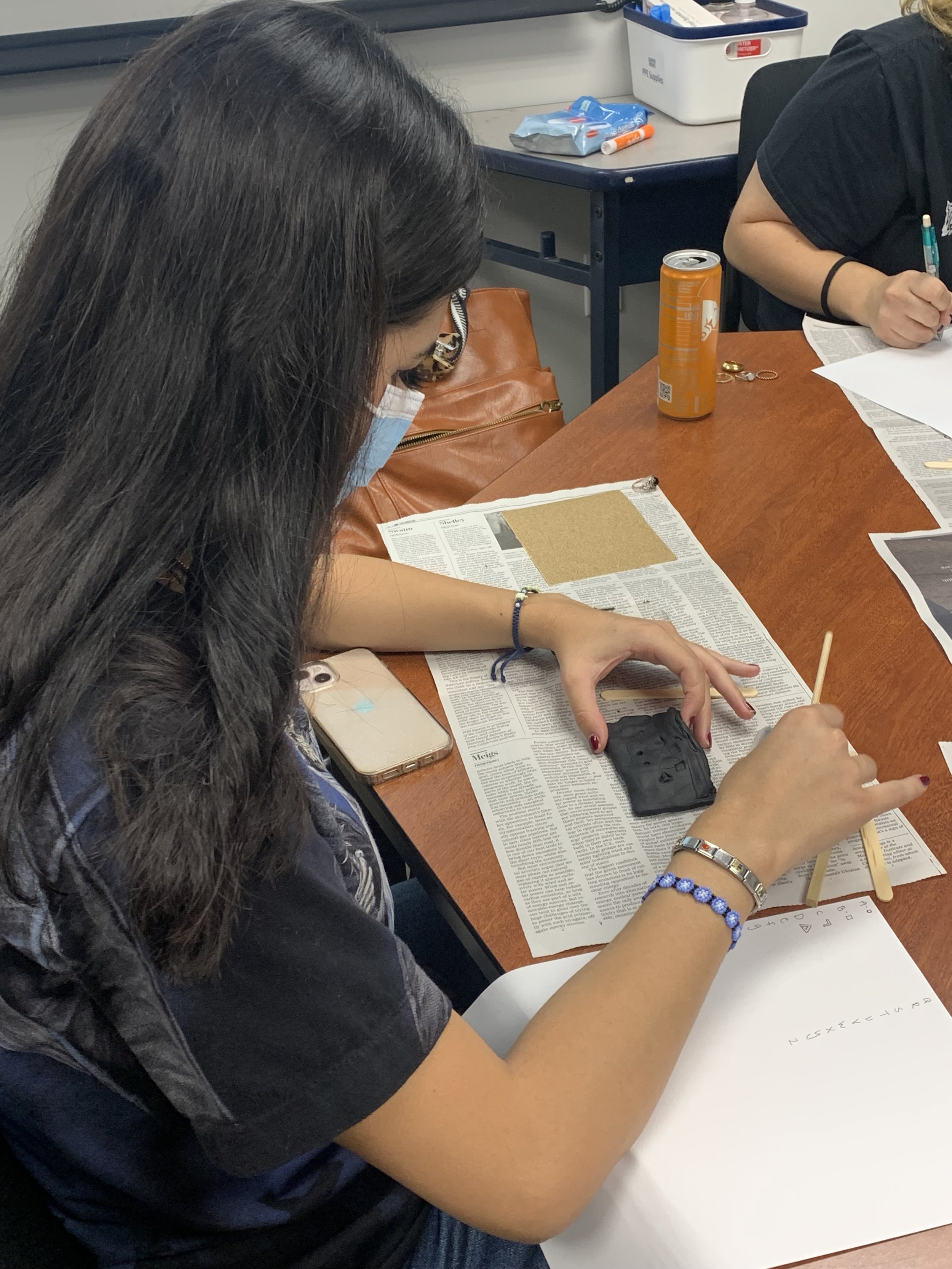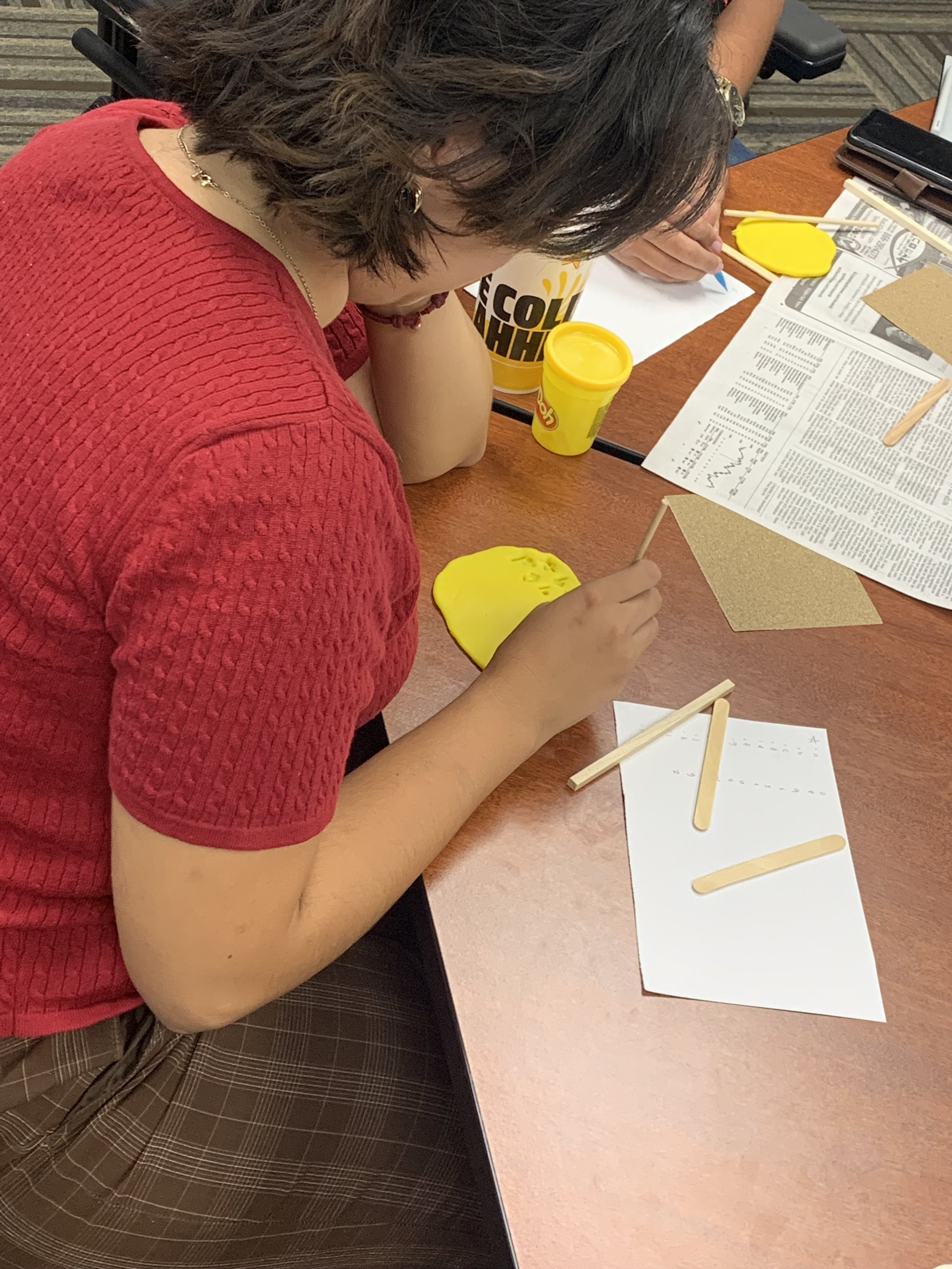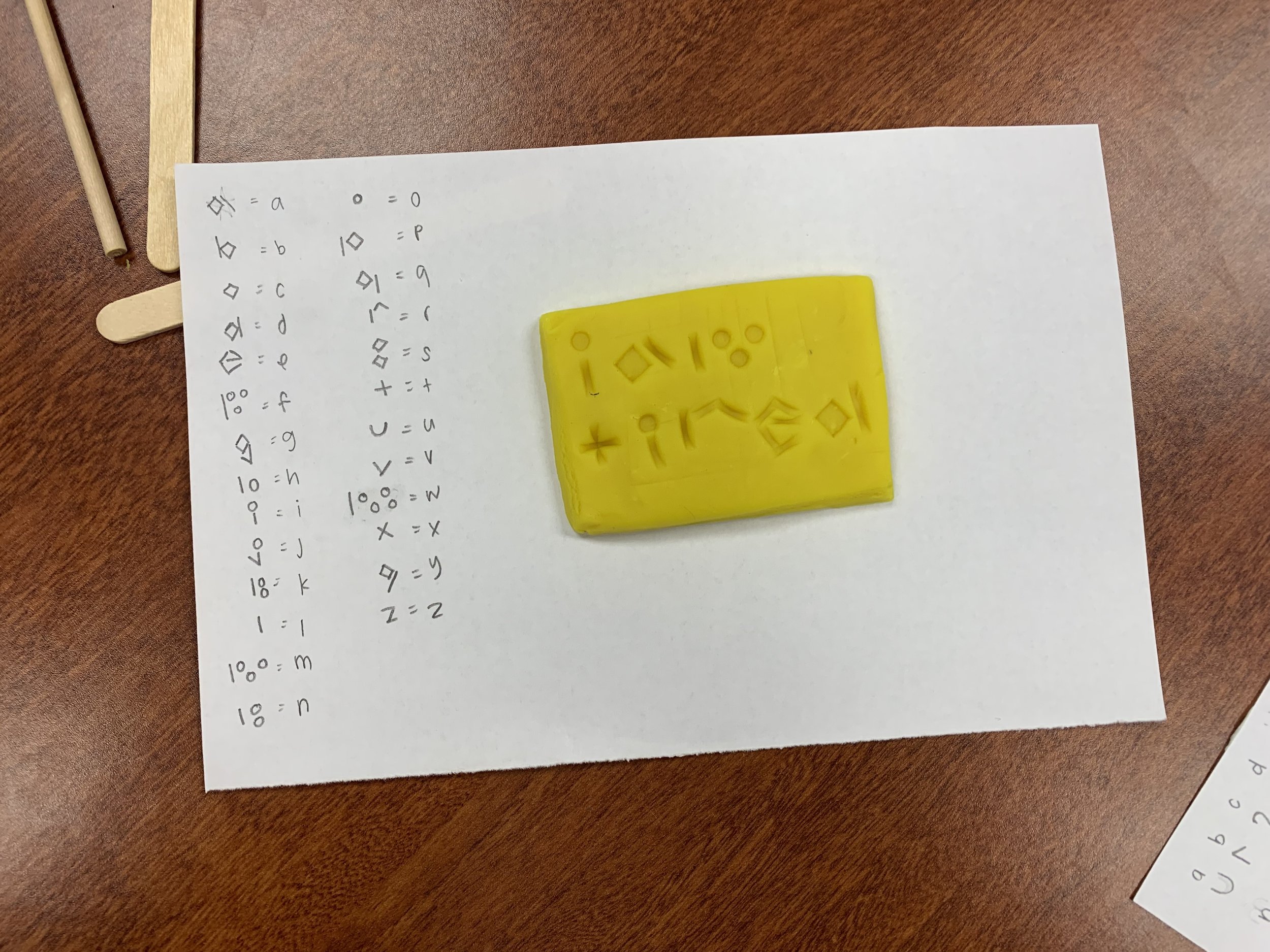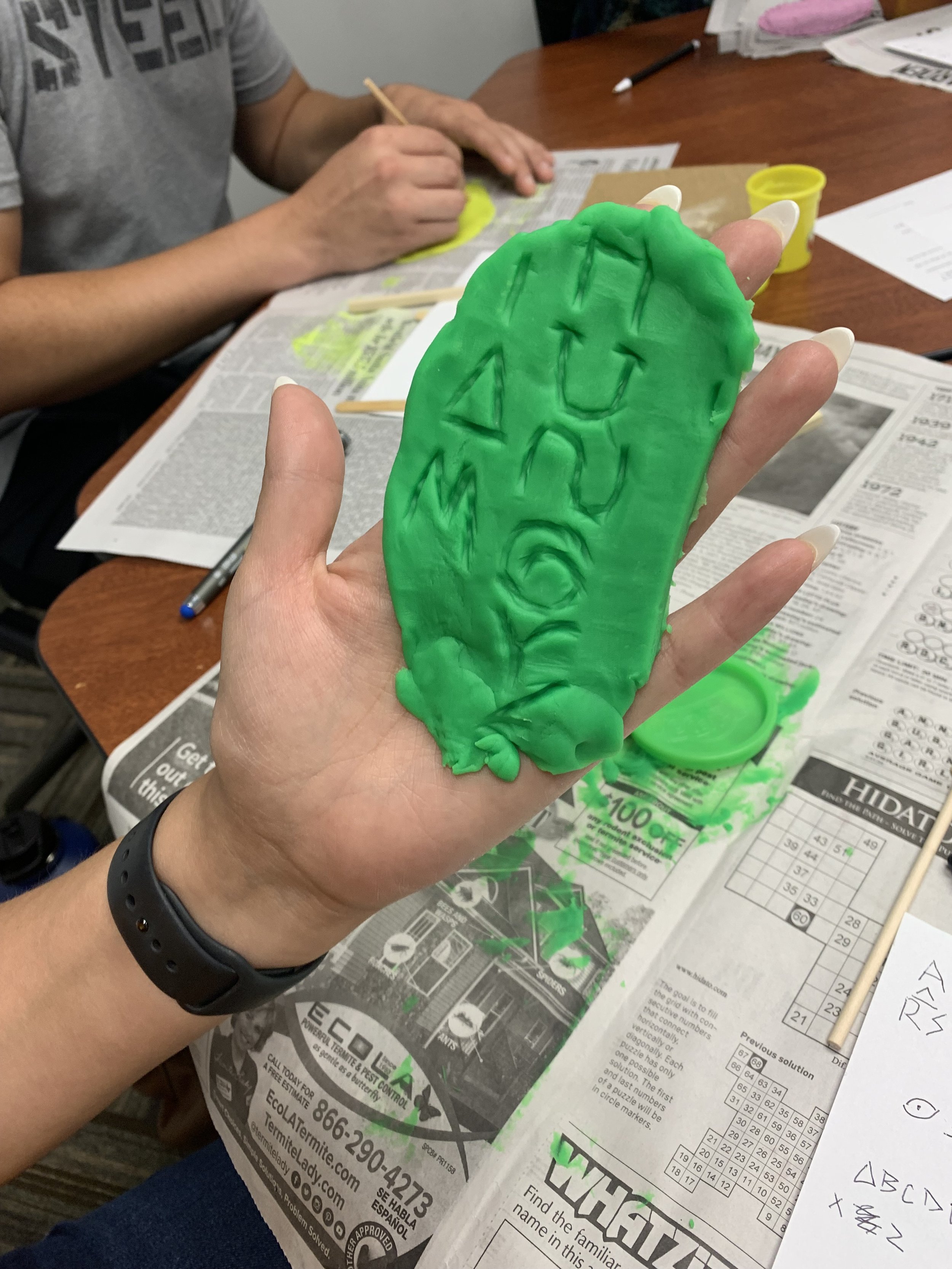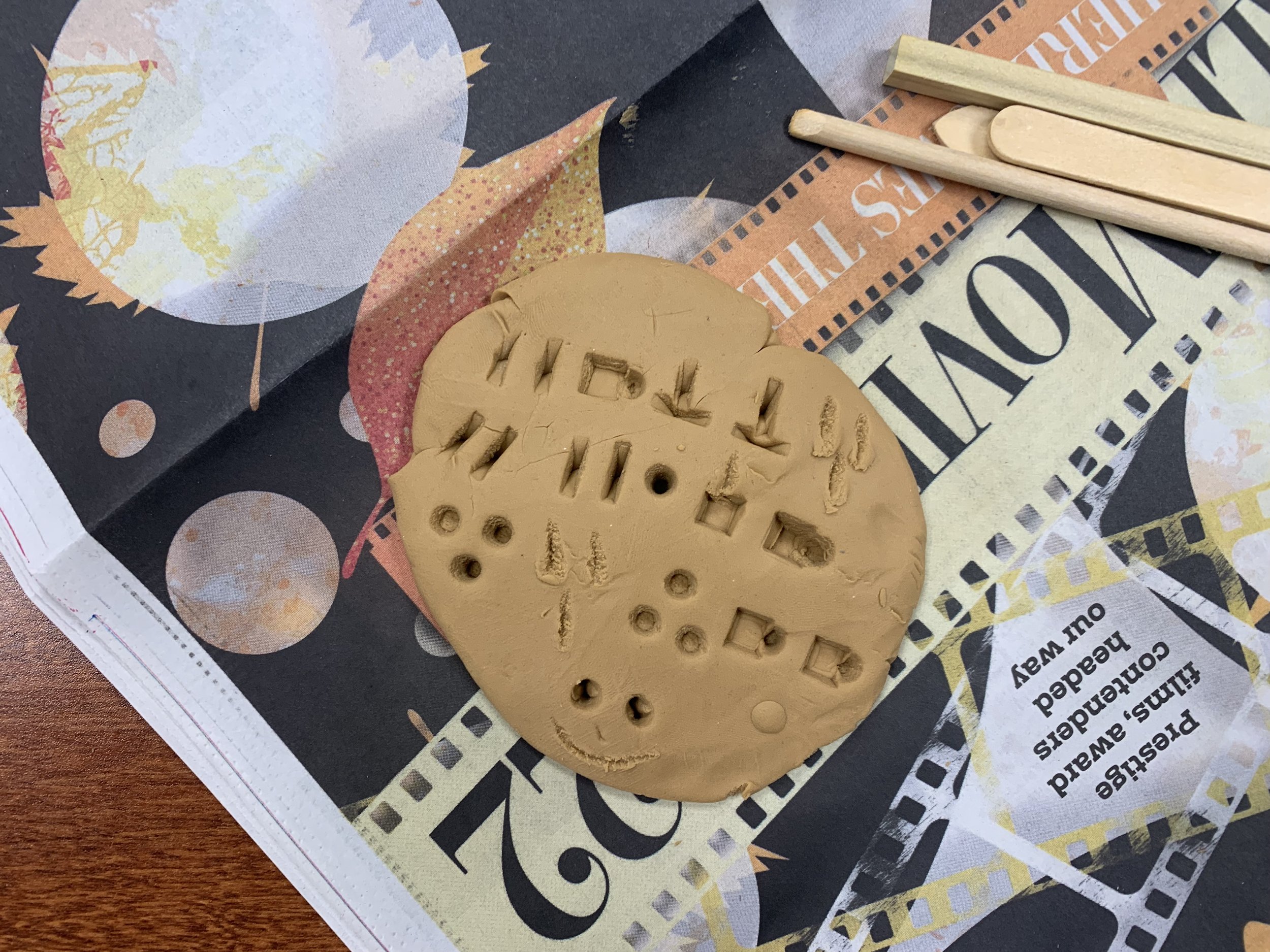Teaching Cuneiform
Posted by Kate Ozment
This post is part of a series covering workshops in a single course called Technologies of Writing. For an overview, see this post.
For the first lesson, we examined pictography with cuneiform and hieroglyphics. Our reading and prep for this lesson included chs. 2 and 3 of Joyce Kinkead’s A Writing Studies Primer that cover the origins of writing and alphabets, syllabaries, and pictography. This lesson had two aspects to it:
Monday, in a 75-minute period, we went over early alphabets and syllabaries, defining these terms and doing informal research on early writing systems in Egypt, Western Asia, Mesoamerica, and China. Small groups quickly taught the rest of the course about each writing system and described the technologies used to accomplish each, varying from brushes and inks to reeds and clay. We spent extra time with syllabaries, as my students were more familiar with alphabets. We used the Cherokee syllabary and wrote out the characters into a phonetic sentence. This allowed us to talk about early printing in the United States with the Eliot bible, and how oral languages can be translated to writing systems in a variety of ways.
Wednesday, in a 75-minute period, we replicated cuneiform using play-doh and wooden implements, which comprises the bulk of this post.
Materials
The workshop required some prep and included the following materials:
A 25-pack of Play-Doh ($20 at Wal-Mart)
Two 24 packs of basswood round dowels, 3/16” diameter and 12” long ($3.14 each at Lowe’s)
Three 12 packs of poplar square dowels, 1/4” diameter and 12” long ($3.98 each at Lowe’s)
One 150 pack of 3/8” craft sticks ($3.98 at Lowe’s)
One pack of 28 count sandpaper sheets, 100 grit ($10 at Lowe’s; not listed online)
Newspaper to collect wood shavings and keep tables clean (about $1.50 a week or use scrap paper)
Each student was given the following:
A small cup of Play-Doh or half of a large one, split between two students
One 6” round dowel (the 12” dowel was cut in half using an X-acto knife and a cutting mat, then sanded smooth)
One 6” square dowel (the 12” dowel was cut in half using a friend’s saw, then sanded smooth")
Two craft sticks
1/4 of a sheet of the sandpaper, cut down with scissors
A single sheet of newspaper
This activity consumes the dowels and sandpaper, though you might be able to reuse these if you reimagine the exercise. The newspaper was recycled after class. I let students keep the Play-Doh creations as I don’t know when I’m teaching this class again and would rather they “baked” their tablets in the sun than have it dry out in my pantry.
Activity
I used a PowerPoint with the following instructions:
Create a writing system, either a syllabary or an alphabet, that will be impressed in the “clay” tablet using wooden instruments.
Shape wooden instruments using sandpaper.
Copy down the “key” to your writing system on a piece of paper.
Write a message on your “clay” tablet and give it, with your key, to a classmate to decode.
Students used scrap paper and pencils to lay out a 26-character alphabet with shapes made from their implements. They used sandpaper to reshape the edges. With two edges toe very implement, they had 8 shapes to work with, and we discussed how shapes could be combined to give a variety of options.
It took most students about 20 minutes to come up with an alphabet they were happy with; most wanted to handle the Play-Doh more than do the writing system (which I sympathize with). Then we started to talk about how to manipulate the “clay.” Many students smooshed it very flat to write their notes, but realized when trying to transfer them to others that they were too soft and likely to lose detail on the impressions. We also discussed how these would have been used — baked and sent across many miles — and decided we would need sturdier structures to survive such a journey.
In using wooden implements to write an alphabet, we were required to think about shapes and the textures and properties of our tools as much as literacy, which was what I wanted this class to push us into. I joked with several of them to think like an engineer not a language person, to make us see what the tools could and could not do. Hopefully this thinking will support our later work in the Maker Studio. Below are some images of their work and alphabets, with the final all of our cuneiform tablets.
About the Author
Kate Ozment is assistant professor of English at California State Polytechnic University, Pomona. She has a book on Hroswitha Club forthcoming from Cambridge UP’s Elements series, and you can find her other work in Textual Cultures, Eighteenth-Century Studies, and Digital Humanities Quarterly. Contact her at: keozment (at) cpp (dot) edu.
-
October 2022
- Oct 16, 2022 Teaching in the Maker Studio Part Two: Safety Training and Open Making
- Oct 16, 2022 Teaching Book Forms
- Oct 16, 2022 Teaching Letterpress with the Bookbeetle Press
-
September 2022
- Sep 24, 2022 Making a Scriptorium, or, Writing with Quills Part Two
- Sep 16, 2022 Teaching Cuneiform
- Sep 4, 2022 We're Back! Teaching Technologies of Writing
-
June 2020
- Jun 1, 2020 Black Lives Matter
- May 2020
-
April 2020
- Apr 1, 2020 Teaching Materiality with Virtual Instruction
- March 2020
-
February 2020
- Feb 1, 2020 Making the Syllabus Zine
-
January 2020
- Jan 1, 2020 Teaching Print History with Popular Culture
-
December 2019
- Dec 1, 2019 Teaching with Enumerative Bibliography
-
November 2019
- Nov 1, 2019 Finding Women in the Historical Record
-
October 2019
- Oct 1, 2019 Teaching in the Maker Studio
-
September 2019
- Sep 1, 2019 Graduate School: The MLS and the PhD
-
August 2019
- Aug 1, 2019 Research Trips: Workflow with Primary Documents
-
July 2019
- Jul 1, 2019 Research Trips: A Beginner's Guide
-
June 2019
- Jun 1, 2019 Building a Letterpress Reference Library
-
May 2019
- May 1, 2019 Teaching Manuscript: Writing with Quills
-
April 2019
- Apr 1, 2019 Why It Matters: Teaching Women Bibliographers
- March 2019
-
February 2019
- Feb 1, 2019 Roundup of Materials: Teaching Book History
-
January 2019
- Jan 1, 2019 Building and Displaying a Teaching Collection
-
December 2018
- Dec 1, 2018 Critical Making and Accessibility
-
November 2018
- Nov 1, 2018 Teaching Bibliographic Format
-
October 2018
- Oct 1, 2018 Teaching Book History Alongside Literary Theory
-
September 2018
- Sep 1, 2018 Teaching with Letterpress
-
August 2018
- Aug 1, 2018 Teaching Manuscript: Circulation
-
July 2018
- Jul 1, 2018 Setting Up a Print Shop
-
May 2018
- May 1, 2018 Teaching Manuscript: Commonplace Books
-
April 2018
- Apr 1, 2018 Getting a Press
-
March 2018
- Mar 1, 2018 Teaching Ephemera: Pamphlet Binding
- February 2018





